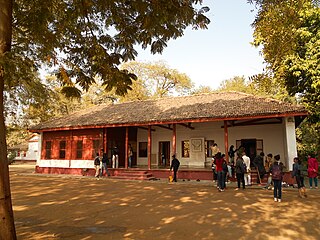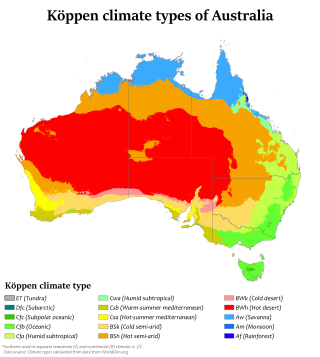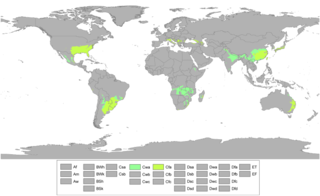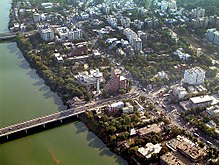
Gandhinagar is the capital of the state of Gujarat in India. Gandhinagar is located approximately 23 km north of Ahmedabad, on the west central point of the Industrial corridor between Delhi, the political capital of India, and Mumbai, the financial capital of India.

Ahmedabad is the most populous city in the Indian state of Gujarat. It is the administrative headquarters of the Ahmedabad district and the seat of the Gujarat High Court. Ahmedabad's population of 8,253,000 makes it the fifth-most populous city in India, and the encompassing urban agglomeration population estimated at 6,357,693 is the seventh-most populous in India. Ahmedabad is located near the banks of the Sabarmati River, 25 km (16 mi) from the capital of Gujarat, Gandhinagar, also known as its twin city.
The Climate of Mumbai is a tropical, wet and dry climate. Mumbai's climate can be best described as moderately hot with high level of humidity. Its coastal nature and tropical location ensure temperatures do not fluctuate much throughout the year.
This page provides a historical timeline of Ahmedabad, the sixth largest city in India.

Sabarmati Ashram is located in the Sabarmati suburb of Ahmedabad, Gujarat, adjoining the Ashram Road, on the banks of the River Sabarmati, 4 miles (6.4 km) from the town hall. This was one of the many residences of Mahatma Gandhi who lived at Sabarmati (Gujarat) and Sevagram when he was not travelling across India or in prison. He lived in Sabarmati or Wardha for a total of twelve years with his wife Kasturba Gandhi and followers, including Vinoba Bhave. The Bhagavad Gita was recited here daily as part of the Ashram schedule.

The Sabarmati river is one of the major west-flowing rivers in India. It originates in the Aravalli Range of the Udaipur District of Rajasthan and meets the Gulf of Khambhat of Arabian Sea after travelling 371 km (231 mi) in a south-westerly direction across Rajasthan and Gujarat. 48 km (30 mi) of the river length is in Rajasthan, while 323 km (201 mi) is in Gujarat.

Faridkot is a city in the South-western part of state of Punjab, India. It serves as the headquarters for both, the Faridkot district. as well as the Faridkot Division. The division was established in 1995 at Faridkot which includes Faridkot, Bathinda and Mansa districts.
The climate of Salt Lake City, Utah features cold and snowy winters, hot and dry summers, and modest to light seasonal rainfall. Lying in the Salt Lake Valley, the city is surrounded by mountains and the Great Salt Lake. Under the Köppen climate classification, Salt Lake City has either a humid subtropical climate (Cfa) or a humid continental climate (Dfa) depending on which variant of the system is used, though it borders on a Mediterranean climate (Csa) or dry-summer continental climate (Dsa) as summers are quite dry.

Khalilabad is a city and a municipal board in Sant Kabir Nagar district in the Indian state of Uttar Pradesh. It is the district headquarters of Sant Kabir Nagar district.
Bhadran is a village in the state of Gujarat, in far western India. It is in the Anand district. Bhadran was nicknamed the "Paris of Gaekwad state" due to its prosperity and civil works carried out by Maharaja Sayajirao Gaekwad III, the visionary ruler of Baroda. It has been called the greatest village in India by Vallabhbhai Patel.

Kalol is a city in Gandhinagar district in the Indian state of Gujarat, located alongside Gujarat State Highway 41 between the cities of Mehsana and Ahmedabad.

The characteristics of United States rainfall climatology differ significantly across the United States and those under United States sovereignty. Late summer and fall tropical cyclones bring precipitation which falls across the Gulf and Atlantic states. During the winter, and spring, Pacific storm systems bring Hawaii and the western United States most of their precipitation. Low pressure systems moving up the East coast bring cold season precipitation to the Mid-West and Northeast states, as well as Great Salt Lake and the Finger Lakes region. The snow to liquid ratio across the contiguous United States averages 13:1, meaning 13 inches (330 mm) of snow melts down to 1 inch (25 mm) of water.
The climate of Delhi is an overlap between monsoon-influenced humid subtropical and semi-arid, with high variation between summer and winter temperatures and precipitation. Delhi's version of a humid subtropical climate is markedly different from many other humid subtropical cities such as São Paulo, New Orleans and Brisbane in that the city features dust storms and wildfire haze due to its semi-arid climate.

Australia's climate is governed mostly by its size and by the hot, sinking air of the subtropical high pressure belt. This moves north-west and north-east with the seasons. The climate is variable, with frequent droughts lasting several seasons, thought to be caused in part by the El Niño-Southern Oscillation. Australia has a wide variety of climates due to its large geographical size. The largest part of Australia is desert or semi-arid. Only the south-east and south-west corners have a temperate climate and moderately fertile soil. The northern part of the country has a tropical climate, varying between grasslands and desert. Australia holds many heat-related records: the continent has the hottest extended region year-round, the areas with the hottest summer climate, and the highest sunshine duration.

Hyderabad is located in central Telangana and is spread over an area of 2,500 km2. The city lies in the Deccan Plateau and rises to an average height of 536 m above the sea level. The city lies at 17.366° N latitude and 78.476° E longitude.
Subhash Bridge is a bridge over Sabarmati River, built in 1973. It is an important area in Ahmedabad for its association with Mahatma Gandhi. Gandhi Ashram is 1.5 km away from Subhash Bridge. Gandhi Ashram Shopping area is a storehouse of Khadi. Subhash Bridge stands as a residential area of Ahmedabad with more than 80 residential societies spread across this place. It has been separated from rest of the city by a railway line in the west and Sabarmati river at its eastern side.

A humid subtropical climate is a zone of climate characterized by hot and humid summers, and cool to mild winters. These climates normally lie on the southeast side of all continents, generally between latitudes 25° and 40° and are located poleward from adjacent tropical climates. It is also known as warm temperate climate in some climate classifications.
Pamol is a small village in Borsad taluka of Anand district in the Indian state of Gujarat. It is located around 6 km north east from Borsad. It is surrounded by the fertile Charotar region which largely produces tobacco, Bananas, rice, cotton, lady finger, tomato, potato, and other agricultural crops. Patel owns the majority of business which is basically farming and farming products. Other major communities are Thakor, Brahmins, Chavda, Vankars, Maheshwari, Muslims and Christians.
Vadeli is a small village in Borsad taluka, Anand district, Gujarat, India. It is located around 8 km from Borsad. It is surrounded by the fertile Charotar region which largely produces tobacco, rice, cotton, lady finger, Tomato, Potato and other agricultural crops. PATEL owns the majority of business, majority of Patels are from 60 house community that dominates Amul Sahkari Madali Milk Dairy and Patel bazar. Other major communities are Darbar, Thakor, Brahmins and Christians. Gandhiji passed through Vadeli Patiya in Dandi March satyagrah, Borsad satyagraha.

Karisalkalampatti is a village in Near sivarakkottai NH7 Main road Thirumangalam Taluk in Madurai District of the Indian state of Tamil Nadu. It is located about 9 km from Thirumangalam, 30 km from Madurai and 520 km from State capital Chennai. As of 2011, the village population about 1158.












